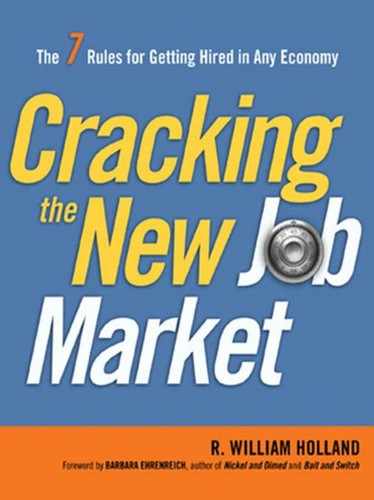PREFACE
This is not just another job-search and career-management book. The rules for finding professional, white-collar work today bear little resemblance to what they were just a few years ago, and there has been little attempt until now to set forth what the new rules are and how to use them to best advantage. For some, the old rules don’t work as quickly as they used to. For a growing number, they do not work at all. And when people can’t find work, they erroneously conclude that the problem is with them—their skill set, ability to keep a job, or just bad luck. Difficulty in finding work today can be a demoralizing, energy-draining experience that saps our self-confidence and jeopardizes our dreams. People—especially white-collar workers—need help; they need to learn the new rules.
Cracking the New Job Market is a myth-busting work that challenges the conventional wisdom. It is also a simple, straightforward explanation of what the new rules are and how to use them.
I recently met an unemployed white-collar worker who had earned three master’s degrees and had accumulated a mountain of student debt in the process. Each master’s was an attempt to retool in response to being laid off. He hoped that more education would inoculate him against further job and career instability. But none of those degrees had that effect. Sadly, this is true for millions of Americans, who still believe in the power of education as the ticket of entry for white-collar work. Often they return to school because they are unsure of what else to do.
Education remains important, but in ways unlike before. Employers want to know something besides whether you have a college degree. This book will help you recognize what employers really want and will give the tools to answer those needs. It will prepare you for work and help you manage your career in this increasingly volatile and competitive environment.
The president of a small manufacturing company in Oklahoma City was gratified when he received the opportunity to move to Chicago and double his income as CEO of a small firm in a related industry. Until now, his career had gone as planned. But two months into his new position, the parent company sold the firm and he was out of a job—with no severance, no bridge back to his old job, and not enough of a personal brand in Chicago to make a go of it in the near term. Bad luck? Perhaps. But the number of professionals with similar experiences seems to be growing exponentially. Even at the highest levels, white-collar work just isn’t as secure as it used to be.
What are the new rules? How can someone develop a career when businesses change hands overnight, when companies send their work overseas, when company loyalty has lost its value? Cracking the New Job Market identifies seven rules that now govern the job market. They provide a laserlike focus on what’s happening in the job market—on what companies are looking for, where they are looking, and how you can put yourself in the spotlight. You will learn how to build a competitive résumé, where the job listings are, how to prepare for interviews and negotiate job offers, what common mistakes people make in choosing a career, and how to bridge the almost inevitable gaps between jobs that all of us are likely to experience, now and in the future.
One rule in particular applies to professional women. If you are a woman in today’s job market, you know that your career will likely be interrupted or affected by conflicting social roles; let’s face it—women have it tougher, though men also sometimes take extended absences from the workplace. But anyone’s interruptions can be damage-controlled—if you follow Rule #7 in this book.
Cracking the New Job Market also touches on some related topics, via its appendixes, such as the role parents need to play in making sure their offspring are career-ready when they leave college. Equally helpful is the essay on long- and short-term financial planning, with an eye toward those trying times when you might be between jobs. And, a final essay surveys the international job market and applies the book’s rules to global employment.
There are no gimmicks in this book. Too many desperate job seekers have been taken in by promises of that “dream job right around the corner”—if only they buy the book, take the course, or join the group. The simple truth is that the world of work—how we prepare for jobs, find and keep them, and find them again when necessary—has undergone a seismic shift. Your chances of success in the job market are improved considerably if you understand these changes and know how to use them to your advantage.
I invite you to comment on the material here and share resources and ideas with other job seekers and career changers. Visit my website at www.crackingthenewjobmarket.com. Depending on your feedback, I will add courses, products, and other resources designed to help you and others crack the new job market.
Acknowledgments
I owe a great deal to many people, especially my siblings (Ruth, June, and Bob), who offered thoughtful suggestions and support throughout this project. The same is true of my sons and their spouses (Todd and Carol, Jaime and Keisha) as well as my niece Laura. In no particular order of magnitude of debt or gratitude, I would also like to thank Jess Womack, Julie Beckett, Tom Luce, John Paine of John Paine Editorial Services, John Talbot of Talbot Fortune Agency, Abby Kraus of Abby Kraus PR, Dan Gross, Marilyn Ross, Ellen Kadin and her team at AMACOM, and others too numerous to mention.
Also, I give special thanks to my good friend Barbara Ehrenreich, who took time out of her busy schedule to write the foreword.
Finally, I thank my wife, Claudia, without whose gentle touch and loving encouragement none of this would have been possible.
